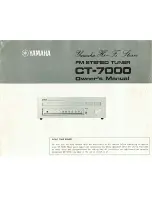
- 2 -
Parts of the AW-LT100G/AW-LT100B
Battery compartment
(Rear)
Battery indicator
Meter
Note name indicator
Reference pitch indicator
Right shuttle switch
Left shuttle switch
Installing the battery
When the battery becomes depleted, a
battery indicator (
) will appear on the
display. Immediately replace the battery with
a new one.
1.
Open the battery compartment cover on the
rear of the tuner in the direction of the arrow.
2.
Insert the battery, making sure to observe the
correct polarity, and then close the cover.
Attaching to the instrument and range of motion
The AW-LT100G/AW-LT100B tunes by picking up the vibrations of the in-
strument. Therefore, attach the AW-LT100G/AW-LT100B to the headstock
of your instrument in order to tune it. Additionally, the AW-LT100G/AW-
LT100B can be freely moved so that the display is easy to read.
The AW-LT100G/AW-LT100B may be damaged if you apply excessive
force within its range of motion, or attempt to move it beyond its in-
tended range of motion.
20°
100°
20°
340°
180°
Please carefully attach the AW-LT100G/AW-LT100B to your instrument.
Leaving the AW-LT100G/AW-LT100B attached for a long time may
damage or mark the instrument's surface.
Depending on various factors such as age-related change or the sur-
face finish, there is a possibility that your instrument may be damaged
by attaching this product.
Tuning
Tuning procedure
1.
Turn the
left shuttle switch
upward. Each time you turn the shuttle
switch, the AW-LT100G/AW-LT100B will be turned on or off.
If the power is left on for approximately 3 minutes without any user
input, it will turn off automatically (Auto power-off function).
2.
If necessary, change the reference pitch (calibration) and meter mode.
3.
Play a single note on your instrument.
The note name closest to the detected pitch appears in the note name
indicator. Check that the correct note name appears in the display, and
then tune your instrument while watching the meter.
The tuning indications differ depending on the selected meter mode
setting.
Even if the pitch is within the range of detection, it may not be possible
to detect the pitch of an instrumental sound that contains large num-
bers of overtones or a sound that has a rapid decay.
The meter may respond to vibrations it picks up from the environ-
ment.
Reference pitch settings (calibration) (*M)
Each time you turn the
right shuttle switch
upward (or downward), the
reference pitch (calibration value) increases (or decreases) in 1 Hz steps.
Setting the meter mode (*M)
Each time you turn the
left shuttle switch
downward, the meter
mode changes.
Regular
¬
Strobe
¬
Half strobe
¬
Regular ...
1: Regular meter
Tune your instrument until the meter segments up to the center (
) light up. If the pitch is sharp, meter segments up to the right of the
center light up. If the pitch is flat, meter segments to the left of the
center light up.
The pitch is flat.
In tune.
The pitch is sharp.
2: Strobe meter
Tune your instrument until the meter segments stop running. Since
the strobe meter has higher precision, it allows you to tune with
greater accuracy. The illumination will flow from left to right if the
note is sharp, or from right to left if the note is flat.
The pitch is flat.
In tune.
The pitch is sharp.
3: Half-strobe meter
Tune your instrument until the meter segment at the center ( )
lights up. If the pitch is sharp, meter segments to the right of the cen-
ter light up. If the pitch is flat, meter segments to the left of the center
light up.
The pitch is flat.
In tune.
The pitch is sharp.
Backlight
After turning the
left shuttle switch
upward to turn on the AW-
LT100G/AW-LT100B, you can change the brightness of the display by
keeping the left shuttle switch turned upward for approximately 2
seconds.
Auto :
The backlight will light brightly when sound is inputted or
when a shuttle switch is operated. When there has been no sound in-
put or shuttle switch operation for approximately three seconds after
the power has been turned on, the backlight will turn off in order to
prevent the battery from being depleted.
Soft :
The backlight will light at a lower level of brightness in order to
prevent the battery from being depleted.
Specifications
Scale:
12-note equal temperament
Range (sine wave):
AW-LT100G B1 (61.74 Hz)–E6 (1319 Hz)
AW-LT100B E0 (20.60 Hz)–C5 (523.3 Hz)
Precision:
+/-0.1 cent
Reference pitch:
A4 = 436–445 Hz (1 Hz steps)
Dimensions (W x D x H):
60 mm x 60 mm x 55 mm / 2.36’’ x 2.36’’ x 2.17’’
Weight:
32 g/1.13 oz. (including battery)
Power supply:
One AAA Battery
Battery life:
approximately 100 hours
(backlight:Soft, tuner continuously operating, A4
input, when using alkaline battery)
Included items:
Owner’s manual, One AAA battery
*M Settings are remembered even when the power is off.
•
Specifications and appearance are subject to change without no-
tice for improvement.


























